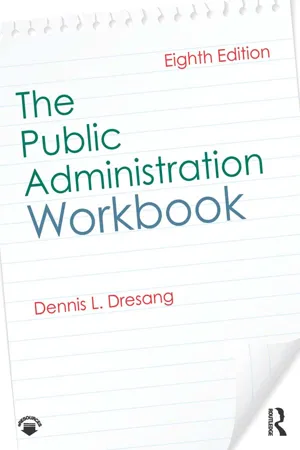
- 360 pages
- English
- ePUB (mobile friendly)
- Available on iOS & Android
The Public Administration Workbook
About this book
Public administration is a craft that demands real-world application of concepts and theories often learned in a classroom. Yet many students find it difficult to make the leap from theory to practice completely unaided. The Public Administration Workbook, 8e is specifically designed with the theoretically-grounded, practice-minded student in mind. It reviews scholarship in political science, law, industrial psychology, and the sociology of organizations and then allows students to see how these intellectual fields inform the analytical and managerial tasks that comprise public administration. Where standard public administration textbooks examine the nature of public agencies and explain how bureaucracies relate to other institutions, this workbook promotes a more effective way of learning—by doing—and more directly prepares those who will pursue careers in public agencies.
Each chapter begins with a discussion of relevant concepts and scholarship before moving into a hands-on exercise analyzing core analytical and management challenges. This edition includes an all-new exercise on contract negotiation, many international examples interwoven throughout the book, and a fully updated HRM section to reflect alternative ranking and compensation systems. Each chapter is further supported by a detailed Instructor's Manual written by the author to guide instructors on solutions, explanations, and ideas for using or modifying the exercises to fit a variety of course needs, as well as downloadable datasets and exercises, providing students with a unique opportunity to apply and test classroom concepts outside of the job.
Frequently asked questions
- Essential is ideal for learners and professionals who enjoy exploring a wide range of subjects. Access the Essential Library with 800,000+ trusted titles and best-sellers across business, personal growth, and the humanities. Includes unlimited reading time and Standard Read Aloud voice.
- Complete: Perfect for advanced learners and researchers needing full, unrestricted access. Unlock 1.4M+ books across hundreds of subjects, including academic and specialized titles. The Complete Plan also includes advanced features like Premium Read Aloud and Research Assistant.
Please note we cannot support devices running on iOS 13 and Android 7 or earlier. Learn more about using the app.
Information
PART I
Decision Making and Policy Analysis
ADMINISTRATORS AND THE POLICY PROCESS
FURTHER READING
Exercise 1
Rational Decision Making
WHAT IS RATIONALITY?
Table of contents
- Cover
- Half Title
- Title Page
- Copyright Page
- Dedication
- Brief Contents
- Table of Contents
- Preface
- Introduction
- Part I. Decision Making and Policy Analysis
- Part II. Public Management
- Part III. Human Resource Management
- Part IV. Budgeting
- About the Author
- Index